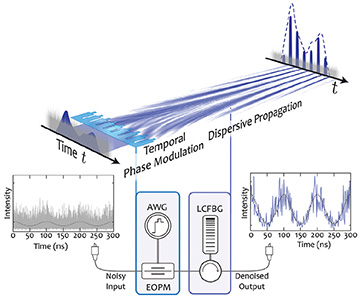 Top: Talbot array illuminator (TAI) denoising scheme coherently sums the signal of interest (blue temporal trace) into narrow pulses that outline an amplified copy of the input signal. This allows the denoised signal to be detected from the resulting peaks. Bottom: Experimental setup relies on a multi-level temporal phase modulation using an electro-optic phase modulator (EOPM) driven by an arbitrary waveform generator (AWG), followed by dispersive propagation via a linearly chirped fiber Bragg grating (LCFBG). [Enlarge figure]
Top: Talbot array illuminator (TAI) denoising scheme coherently sums the signal of interest (blue temporal trace) into narrow pulses that outline an amplified copy of the input signal. This allows the denoised signal to be detected from the resulting peaks. Bottom: Experimental setup relies on a multi-level temporal phase modulation using an electro-optic phase modulator (EOPM) driven by an arbitrary waveform generator (AWG), followed by dispersive propagation via a linearly chirped fiber Bragg grating (LCFBG). [Enlarge figure]
Although noise mitigation crosses many boundaries in science and technology, current solutions, interestingly, rely on a handful of techniques. By far the most common solution consists of bandpass filtering—attenuating all the energy outside of the frequency bandwidth of the signal. In the optical domain, a variety of well-established technologies exist for this purpose. Yet significant disadvantages remain, particularly when the waveforms are either very narrowband (below a few GHz) or very broadband (sub-THz regime and above).
To optimally denoise a narrowband signal, the filter’s bandwidth should match that of the signal. However, not only are optical filters with passbands just below a few GHz challenging to realize,1 but sophisticated feedback control may be needed to track the varying central frequency of a signal to maintain alignment—which is difficult to achieve if the signal is hardly detectable due to noise. In the case of broadband signals, the main problem is that most of the noise may actually be contained within the bandwidth of the signal itself, for which a bandpass filter will have absolutely no effect.2
We recently devised a noise-mitigation technique that focuses the energy of a coherent signal into a series of peaks that outline an amplified copy of the input signal. Based on a time- or frequency-domain realization of the Talbot array illuminator,3 it consists of lossless phase-only manipulations analogous to a discretized time-lens. Since the energy redistribution relies on coherent addition, the deterministic signal is amplified while the incoherent noise is left effectively untouched.
The technique can be employed for amplification of either the time- or frequency-domain representations of the waveform in a real-time, single-shot and self-tracking manner. The time-domain implementation is particularly interesting for noise mitigation of narrowband signals, demonstrated well below the MHz range. It also allows for simultaneously processing multiple wavelength-multiplexed signals, as found in fiber optic telecommunications.4 In a complementary way, the frequency-domain realization enables efficient in-band noise mitigation in ultrafast optical waveforms, without requiring any information on the time of arrival of the incoming waveform.5
We believe this framework brings a new perspective to the noise-mitigation problem. Moreover, as the technique relies exclusively on common wave manipulations, we predict that it can be adapted to any wavelike support, including acoustics, microwaves, plasmonics or quantum waves.
Researchers
Benjamin Crockett and José Azaña, Institut National de la Recherche Scientifique (INRS), Montréal, QC, Canada
Luis Romero Cortés, INRS, Montréal, QC, Canada, and Universitat Politècnica de València, València, Spain
Saikrishna Reddy Konatham, INRS, Montréal, QC, Canada, and Infinera, Ottawa, ON, Canada
Reza Maram, Fonex, Montréal, QC, Canada
References
1. M.P. Fok and J. Ge. Photonics 4, 45 (2017).
2. I.S. Bozchalooi and M. Liang. Mech. Syst. Sig. Process. 22, 915 (2008).
3. A.W. Lohmann. Optik 79, 41 (1988).
4. B. Crockett et al. Optica 9, 130 (2022).
5. B. Crockett et al. Nat. Commun. 12, 2402 (2021).
